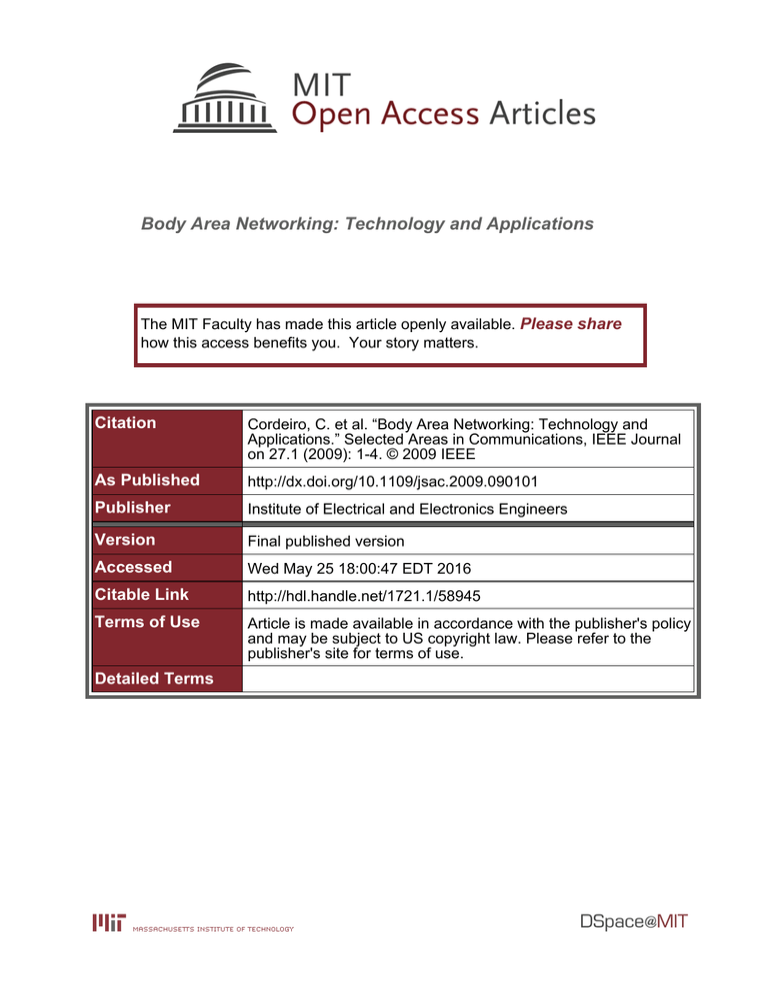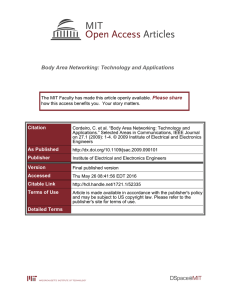Body Area Networking: Technology and Applications Please share
advertisement

Body Area Networking: Technology and Applications The MIT Faculty has made this article openly available. Please share how this access benefits you. Your story matters. Citation Cordeiro, C. et al. “Body Area Networking: Technology and Applications.” Selected Areas in Communications, IEEE Journal on 27.1 (2009): 1-4. © 2009 IEEE As Published http://dx.doi.org/10.1109/jsac.2009.090101 Publisher Institute of Electrical and Electronics Engineers Version Final published version Accessed Wed May 25 18:00:47 EDT 2016 Citable Link http://hdl.handle.net/1721.1/58945 Terms of Use Article is made available in accordance with the publisher's policy and may be subject to US copyright law. Please refer to the publisher's site for terms of use. Detailed Terms IEEE JOURNAL ON SELECTED AREAS IN COMMUNICATIONS, VOL. 27, NO. 1, JANUARY 2009 1 Guest Editorial Body Area Networking: Technology and Applications ecent advances in the domain of personal gadgets, sensing and monitoring technology for in-body and near-body use, miniaturization, and energy-efficient wireless and sensor networks have recently come together under the rubric of Body Area Networks (BAN). Body Area Networks, as the name suggests, is a network of computing entities around a person that is used to provide important services. BANs can be utilized in diverse applications such as physiological and medical monitoring, human computer interaction, education and entertainment. The last decade has seen a dramatic increase in the number of computing devices surrounding an average person. Apart from the more macro platforms such as cell phones and laptops, computing devices are now being worn or even implanted into patients and used to monitor various aspects of wearer’s physiology and ambient environment. Examples include heart-rate monitors, glucose-monitors, accelerometers, medical implants and so on. These entities are often wearable, forming part of a person’s existing apparel of a person such as a watch, ring, bracelet or piece of clothing. This has led to a change in way we perceive computing and computers. Computers are no longer solely stand-alone special purpose entities, or networked entities embedded in our extended environments. Rather, they are becoming a part of the intimate zone of the human body enhancing our capabilities to monitor, perform, improve and entertain ourselves. In comparison to traditional wireless sensor and ad hoc networks, BANs present several new and unique research challenges due to signal propagation characteristics in and around a human body and the need for safe, secure, and dependable operation with ability to operate for long periods of time. Recently, many research groups in the industry and academia have proposed several solutions toward improving the state of the art in BANs. There are many initiatives to investigate, including issues such as communication protocols, usability issues, security and privacy maintenance, in-body and nearbody signal propagation and signal processing. The purpose of this special issue is to bring together researchers and practitioners working on diverse aspects of this important emerging area in order to identify current status, fundamental issues, future problems, and applications. Here we present six articles selected from the 26 papers that were submitted. Certainly, we could not cover all aspects of BANs in this special issue; accordingly we have classified the selected articles into three categories: Antennas and propagation, Communication protocols, and Context processing. R Digital Object Identifier 10.1109/JSAC.2009.090101 ANTENNAS AND PROPAGATION The first article titled “Cooperative Communications in UltraWideband Wireless Body Area Networks: Channel Modeling and System Diversity Analysis” by Chen et al. explores the application of cooperative communications between two BANs. It addresses channel propagation issues in BANs which utilize ultra-wide band (UWB) based communication. The second article in this category titled “Performance of UWB Receivers with Partial CSI Using a Simple Body Area Network Channel Model” by Zasowski et al. investigates the impact of partial channel state information at the receiver on the detection performance. The article derives symbol-wise maximum-likelihood detectors for pulse position modulation and transmitted-reference pulse amplitude modulation along with evaluating their performance. The third article in this category titled “An Antennas and Propagation Approach to Improving Physical Layer Performance in Wireless Body Area Networks” by Conway et al. investigates techniques to improve the link conditions in BANs. In this regard, the article introduces a novel wearable antenna based upon an innovative design which is suitable for integration with BAN nodes and evaluates its performance. COMMUNICATION PROTOCOLS The article in this category titled “Transmission Power Control in Body Area Sensor Networks for Healthcare Monitoring” by Xiao et al. investigates the opportunities and challenges in the use of dynamic radio transmit power control for prolonging the lifetime of health monitoring BANs. The article presents the advantages of dynamic transmission power control by illustrating its efficiency over using static transmission power control methods, along with developing a class of practical on-line schemes that adapt transmission power dynamically based on feedback from the receiver. CONTEXT PROCESSING The first article in this category titled “Modeling ServiceOriented Context Processing in Dynamic Body Area Networks” by Lombriser et al. explores real-time context processing in BANs taking into account the dynamic topological and contextual changes, and heterogeneous processing capabilities and energy constraints present on the available devices. The article proposes a service-oriented framework for the execution of context recognition algorithms. It also theoretically analyzes the performance of various components of the framework, including the sensor network organization, service discovery, service graph construction, service distribution and mapping. 0733-8716/09/$25.00 © 2009 IEEE 2 IEEE JOURNAL ON SELECTED AREAS IN COMMUNICATIONS, VOL. 27, NO. 1, JANUARY 2009 The second and final article in this category titled “EnergyEfficient Information-Driven Coverage for Physical Movement Monitoring in Body Sensor Networks” by Ghasemzadeh et al. investigates energy-efficient sensor coverage techniques for movement monitoring in BANs utilizing inertial sensors. The article presents theoretical models allowing it to consider the sensing coverage from a collaborative signal processing perspective, while eliminating redundant sensor nodes and yet maintaining the quality of service. Clearly, the articles in this special issue can only cover a sub-selection of the issues in BAN. We hope, however, that this set of articles gives the reader a broad appreciation of the remaining challenges in BANs and the progress the research community is making in addressing some of them. We wish to thank Prof. D. Lee and Prof. P. Cosman, editors of J-SAC, for their advice, encouragement and patience during the process of putting together this Special Issue. We also thank the various reviewers who greatly helped us in selecting the best articles. We hope you will enjoy this special issue as much as we enjoyed putting it together Carlos Cordeiro, Guest Editor Wireless Commun. and Networking Dept. Philips Research North America Briarcliff Manor, NY Carlos.Cordeiro@philips.com Romano Fantacci, Guest Editor Dipt. di Elettronica e Telecomunicazioni University of Florence Florence, Italy Romano.Fantacci@unifi.it Sandeep Gupta, Guest Editor Dept. of Comp. Science and Engineering Arizona State University Tempe, AZ sandeep.gupta@asu.edu Joseph Paradiso, Guest Editor Media Lab Massachusetts Institute of Technology Cambridge, MA joep@media.mit.edu Asim Smailagic, Guest Editor Institute for Complex Engineered Systems Carnegie Mellon University Pittsburgh, PA asim@cs.cmu.edu Mani Srivastava, Guest Editor Electrical Engineering Dept. University of California at Los Angeles Los Angeles, CA mbs@ee.ucla.edu David Lee, J-SAC Board Representative Carlos Cordeiro works in the Wireless Communication Lab at Intel’s Communication Technology Group. He has been working with wireless communication for many years, including cognitive radios, multi-Gbps wireless networks, body area networks, ad hoc and sensor networks, and MIMO. Due to his contributions to the wireless area, Dr. Cordeiro received the 2007 IEEE New Face of Engineering Award and the IEEE Region 1’s 2007 Technological Innovation Award. Dr. Cordeiro was also part of the team that received the 2007 Frost & Sullivan Excellence in Research of the Year Award. He is an Editor of IEEE Transactions on Wireless Communications and has served as Guest Editor of various IEEE JSAC and ACM special issues. He is the author of the textbook Ad Hoc and Sensor Networks: Theory and Applications, and has been an active participant in standardization activities including IEEE 802.11, IEEE 802.15, IEEE 802.22 and ECMA. Dr. Cordeiro delivered several tutorials in the wireless area, has served as Chair and TPC member of various conferences, has published over 75 papers in the wireless area alone, and holds tens of patents. Romano Fantacci was born in Pistoia, Italy. He graduated from the Engineering School of the Universit di Firenze, Florence, Italy, with a degree in electronics in 1982. He received his Ph.D. degree in telecommunications in 1987. After joining the Dpt. of Elettronica e Telecomunicazioni as an assistant professor, he was appointed associate professor in 1991 and full professor in 1999. His current research interests are digital communications, computer communications, queuing theory, satellite communication systems, wireless broadband communication networks, ad-hoc and sensor networks. He has been involved in several European Space Agency (ESA) and INTELSAT advanced research projects. He is the author of numerous articles published in prestigious communication science journals. He guest edited special issues in IEEE journals and magazines and served as symposium chair of several IEEE conferences, including VTC, ICC and Globecom. Professor Fantacci received the IEE IERE Benefactor premium in 1990 and IEEE COMSOC Award Distinguished Contributions to Satellite Communications in 2002. He is currently serving as Associate Editor for Telecommunication Systems, International Journal of Communications Systems, IEEE Transactions Communications, and Area Editor for IEEE Transactions on Wireless Communications. IEEE JOURNAL ON SELECTED AREAS IN COMMUNICATIONS, VOL. 27, NO. 1, JANUARY 2009 Sandeep Kumar S. Gupta is a Professor with the School of Computing and Informatics, Arizona State University, Tempe, USA. He received the B.Tech degree in Computer Science and Engineering (CSE) from Institute of Technology, Banaras Hindu University, Varanasi, India, M.Tech. degree in CSE from Indian Institute of Technology, Kanpur, and M.S. and Ph.D. degree in Computer and Information Science from Ohio State University, Columbus, OH. His current research focuses on dependable, criticality aware, adaptive distributed systems with emphasis on wireless sensor networks, thermal and power-aware computing and communication, and pervasive healthcare. He has co-authored the book “Fundamentals of Mobile and Pervasive Computing,” McGraw Hill, and is currently on the editorial board of IEEE Communication Letters and a co-guest editor for various IEEE journals. He is a member of the ACM and a senior member of the IEEE. Dr. Gupta heads the IMPACT (Intelligent Mobile and Pervasive Applications and Computing Technologies) Lab at Arizona State University. For information about his recent research projects and publications please visit http://impact.asu.edu. Joseph Paradiso joined the MIT Media Laboratory in 1994, where he is now an Associate Professor of Media Arts and Sciences directing the Responsive Environments Group, which explores the development and application new sensing modalities and enabling technologies that create new forms of interactive experience and expression. He is an expert on sensing technology for human-computer interfaces, having developed and fielded a wide variety of systems that track human activity using electric field sensing, microwaves, ultra-low-cost laser ranging, passive and active sonar, piezoelectrics, and resonant electromagnetic tags. His work has found application in areas such as interactive music systems, wearable computers, smart highways, and medical instrumentation. He is also serving as co-director of the Things That Think Consortium, a group of Media Lab researchers and industrial sponsors examining the extreme future of embedded computation and sensing,. He is the winner of a 2000 Discover Magazine Award for Technical Innovation, and his work has been shown at many notable international venues, ranging from the Ars Electronica Center in Linz, Austria to the Museum of Modern Art in Manhattan. Paradiso received a B.S. in electrical engineering and physics summa cum laude 3 from Tufts University in 1977, and in 1981 completed a Ph.D. in physics from MIT with Prof. Ulrich Becker as a K.T. Compton Fellow in the Nobel Prize-winning group headed by Prof. Samuel C.C. Ting at the Laboratory for Nuclear Science. His dissertation research was based on an experiment measuring high-energy muon pair production at the European Center for Nuclear Research (CERN) in Geneva, Switzerland. From 1981 to 1984 he conducted post-doctoral research at the Swiss Federal Institute of Technology (ETH) in Zurich, where he developed precision drift chambers and fast electronics for the inner tracker of the L3 experiment at CERN/LEP. From 1984–1994 he was a physicist at the Draper Laboratory in Cambridge, Massachusetts, where, as a member of the NASA Systems and Advanced Sensors and Signal Processing Directorates, his research encompassed control algorithms for orbital and re-entry spacecraft, sonar systems for advanced underwater applications, fractal-based image processing, and high-energy physics detectors. From 1992–1994, he directed the development of precision alignment sensors for the GEM muon detector at the Superconducting Supercollider, and was a visiting scientist at ETH-Zurich in 1991 and 1992 to design fast pattern-recognition algorithms for triggering an electromagnetic crystal calorimeter at the CERN Large Hadron Collider (LHC). In addition to his physics career, Paradiso has been designing electronic music synthesizers and composing electronic music since 1975, and long been active in the avantgarde music scene as a producer of electronic music programs for non-commercial radio. He has built (and still uses) one of the world's largest modular synthesizers, and has designed MIDI systems for internationally-known musicians such as Pat Metheney and Lyle Mays. Paradiso has frequently published and internationally lectured in many areas, including highenergy physics, spacecraft control, sensor systems, and interactive media. Asim Smailagic is a research professor at the Institute for Complex Engineered Systems, the College of Engineering, and the Department of Electrical and Computer Engineering at Carnegie Mellon University (CMU). He is also the director of the Laboratory for Interactive and Wearable Computer Systems at CMU. This lab has designed and constructed more than two dozen generations of novel mobile/wearable computer systems over the last 12 years. He received the Fulbright postdoctoral award at Carnegie Mellon Univeristy in computer science in 1988, has been a program chairman of seven IEEE conferences, and was program chairman of the Cambridge Conference on High Performance Distributed Computer Systems ’89. He has acted as guest editor and associate editor in many leading archival journals, is one of the cofounders of the IEEE Symposium on 4 IEEE JOURNAL ON SELECTED AREAS IN COMMUNICATIONS, VOL. 27, NO. 1, JANUARY 2009 Wearable Computers, and is a new chair of the IEEE Technical Committee on Wearable Information Systems. He was a recipient of the 1992 Tempus European Community Award for scientific cooperation resulting in new curriculum development, the 2000 Allen Newell Award for Research Excellence from Carnegie Mellon’s School of Computer Science, the 2003 Carnegie Science Award for Excellence in Information Technology, and the 2003 Steve Fenves Award for Systems Research from CMU’s College of Engineering. He has written or edited several books in the areas of computer systems design and prototyping, mobile computers, and VLSI system design. His research interests include pervasive context aware computing, wearable computers, human centric computing, and rapid prototyping of computer systems. He has made major contributions to several projects that represent milestones in the evolution of advanced computer systems: from CMU’s Cm* Multiprocessor System and Edinburgh MultiMicroprocessor Assembly (EMMA) to CMU’s current projects on wearable computer systems, smart modules, Communicator, Aura pervasive computing, and the RADAR Personal Cognitive Assistant. He is a senior member of the IEEE. Mani Srivastava received his B.Tech. in 1985 from I.I.T. Kanpur, and M.S. and Ph.D. in 1987 and 1992 respectively from U.C. Berkeley. After working for five years at Bell Labs Research at Murray Hill, NJ, he joined UCLA’s faculty in 1997 where he is currently Professor and Vice Chair (Graduate Affairs) in Electrical Engineering, and Professor of Computer Science. He is also affiliated with NSF Science and Technology Center on Embedded Networked Sensing where he co-leads the System Research Area. His research interests are in embedded systems, lowpower design, wireless networking, and pervasive sensing. He received the President of India’s Gold Medal in 1985, the NSF Career Award in 1997, and the Okawa Foundation Grant in 1998. He currently serves as the Editor-in-Chief of the ACM Sigmobile Mobile Computing and Communications Review, and as Associate Editor for the ACM/IEEE Transactions on Networking, and ACM Transactions on Sensor Networks.



